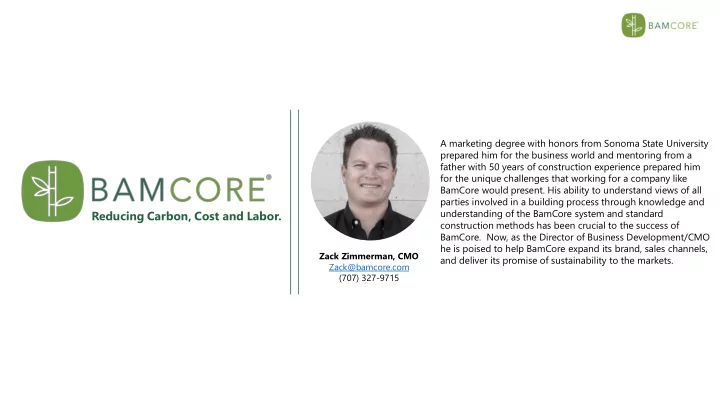

A marketing degree with honors from Sonoma State University prepared him for the business world and mentoring from a father with 50 years of construction experience prepared him for the unique challenges that working for a company like BamCore would present. His ability to understand views of all parties involved in a building process through knowledge and understanding of the BamCore system and standard Reducing Carbon, Cost and Labor. construction methods has been crucial to the success of BamCore. Now, as the Director of Business Development/CMO he is poised to help BamCore expand its brand, sales channels, Zack Zimmerman, CMO and deliver its promise of sustainability to the markets. Zack@bamcore.com (707) 327-9715
THE PROBLEM: CARBON + COST + LABOR The global built environment generates the largest carbon footprint of any economic sector, suffers from rising construction costs, and is being strangled by declining skilled labor pools. Carbon / Energy The residential and commercial sectors of the built 40% environment produce 40% of CO2 emissions in the U.S per year, more than any other sector. Cost The amount construction costs have increased for 110% single family homes over the last two decades, or 6% per year, due to stagnant productivity growth. Labor The number of builders reporting having a difficult 91% time finding skilled workers; skilled labor shortages drive up costs while slowing completion.
THE TIMING: WHY NOW? Top builders and developers are seeking a cost-effective solution to codes going green and for shrinking labor pools. Job Openings (000’s) 500 400 Building ng Construction Clim imate Code de The shift to Chang nge 300 job openings Changes green building outpace 200 has begun. supply. Consumer r 100 Sustainabil bility ty Aware rene ness 0 2010 2011 2012 2013 2014 2015 2016 2017 2018 2019 2020 Nationwide building code changes are driving higher energy Unfilled construction job openings continue to rise. Eighty percent efficiency and larger waste reduction requirements than current of construction firms said they are having trouble hiring hourly practices can deliver. And in many locations, policies reacting to craftsmen and 81% percent expected that hiring would remain climate change are enforcing lower carbon footprint solutions. difficult or become harder. Consumer green preferences are also driving safer, more sustainable purchases and awareness. BamCore’s solution lowers the need for skilled and BamCore’s solution delivers the highest operating unskilled jobs site labor. performance with the lowest carbon impact.
OUR SOLUTION To address the carbon, cost, and labor crises we must… Change the material We use nature’s strongest and most sustainable fiber, timber bamboo, which sequesters 5x the carbon of wood, is 20% stiffer than steel, and 38% stronger than Douglas Fir. and Change the method We harness the power of industrial construction, combining digital job engineering and materials science with pre- fabricated manufacturing technologies.
The Environmental Benefits of Integrating Timber Bamboo into Durable Construction Products
GLOBAL SUPPLY: ENVIRONMENTALLY SUSTAINABLE Timber Bamboo sequesters 5-6x more CO 2 than similar structural wood. • Timber bamboo is harvested annually after 7-10 years; wood is harvested once every 25-75 years – shorter harvest cycles means more carbon sequestered in products. • Clear-cutting is never used with timber bamboo because every year shoots continue to grow from the rhizome (root system) – this allows soil carbon to remain intact. • Our research finds timber bamboo could be a key tool in climate change mitigation.
GLOBAL SUPPLY: CARBON Timber bamboo sequesters ~200 Mt C per hectare than wood species used for traditional framing. † 300 Avg. Carbon (tonnes) / hectare Timber bamboo: 251 Mt/ha 250 200 150 100 Wood: 61 Mt/ha 50 0 1 3 5 7 9 11 13 15 17 19 Years after planting † Carbon Farming with Timber Bamboo, Hinkle et al.
Our first product: the Prime Wall System.
THE PRIME WALL SYSTEM: INTRO The patented Prime Wall System is a code-compliant, panelized wall system that uses engineered bamboo- wood composite panels to construct pre-fabricated hollow walls.
THE PRIME WALL SYSTEM: LESS IS MORE To build to code, a builder needs a fraction of the materials and labor when using BamCore. Traditional framing The Prime Wall System Prime Wall Panels Drywall Eliminate Drywall Headers and Reduced 16o.c. studs framing Jack and Eliminate jack king studs and king studs Increase Insulation insulation OSB Eliminate OSB Continuous foam Eliminate continuous insulation foam insulation Furring Strips Eliminate furring strips Simple siding installation Siding
THE PRIME WALL SYSTEM: LESS IS MORE The Prime Wall System Traditional framing
IMPROVED: THE PRIME WALL SYSTEM: PERFORMANCE +80% Thermal resistance -50% Energy demand The Prime Wall Vertical load +50% bearing outperforms -47% Flame spread traditional framing in every category. Sound -50% transmission -83% Air leakage Improved Carbon Reduce 223 Mt CO 2 per house equivalent Footprint
Reducing Carbon, Cost and Labor.
Recommend
More recommend